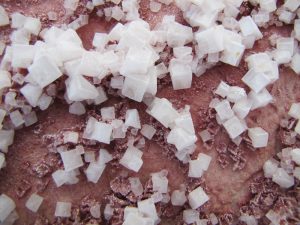
Halite, better known as salt, is so commonplace it’s easy to forget halite is a collectible mineral with its perfectly formed, sharp-edged cubic crystals. Its hygroscopicity and distinctive taste set it apart from all other minerals and account for its great economic importance and prominent role in history. Pass the salt!
Ionic Bonding

Halite’s unique properties are because of ionic bonding, the attraction between ions of metallic elements (sodium) and nonmetallic elements (chlorine).
Atoms are considered stable when their outer shells contain eight electrons. Atoms with fewer than eight outer electrons achieve stability by gaining, losing, or sharing electrons. Both sodium and chlorine atoms have three shells. Sodium, with one outer-shell electron, achieves stability by losing its electron to create the positively charged sodium cation Na1+. Chlorine, with seven electrons in its outer shell, achieves stability by acquiring an electron from another atom to create the negatively charged chlorine anion Cl1-.
When chlorine atoms contact sodium atoms, chlorine aggressively grabs sodium’s single outer electron, transforming both atoms into oppositely charged ions. This opposite-charge attraction is the ionic bond that holds sodium and chlorine ions together in the stable halite molecule.
Structure and Solubility
Halite’s crystal lattice consists of alternating rows of sodium and chlorine ions arranged in three axial directions at right angles in a cubic structure. Because ionic bonding is relatively weak, moderate mechanical pressure easily separates the rows to account for halite’s perfect, three-directional cleavage and its softness of Mohs 2.0.

Wikimedia Commons
The interaction of ionic bonding and water molecules is responsible for halite’s properties of solubility, hygroscopicity and taste. In the asymmetrical water molecule (H2O ), two hydrogen atoms are positioned together on one side of the larger oxygen atom. This creates a dipolar molecule with a weak positive charge on the hydrogen side and a negative charge on the opposite side. The mutual attraction between water’s dipolar molecules, called hydrogen bonding, is strongest at cold temperatures—the reason why water freezes into solid ice.
When water’s dipolarity disrupts halite’s ionic bonding, the halite quickly disassociates into soluble sodium and chlorine ions. This, in turn, disrupts water’s hydrogen bonding to lower its freezing point—thus making halite an effective deicing agent for winter highways.
“Pass the Salt”

Wikimedia Commons
The sensation of taste is created when soluble compounds disassociate into ions that are detectable by the tongue’s taste buds. Halite’s “table-salt” taste, the most familiar and recognizable of all mineral tastes, is produced when taste buds react to the presence of sodium ions.
Besides imparting its own distinctive taste, salt helps ions in other foods to disassociate, dissolve, and impart their own unique stimuli to the taste buds. The five basic tastes are bitter, sweet, sour, umami (savory or meaty), and salty. Salt decreases bitterness and enhances all other tastes.

Steve Voynick
Hygroscopicity
Hygroscopicity, the ability to attract and retain water causes table salt to “cake.” This is a common inconvenience in humid climates. When moisture disrupts halite’s ionic bonds, both its positively charged sodium and negatively charged chlorine ions attract and hold dipolar water molecules.
Because salt draws water from the cells of microorganisms, thus destroying their metabolism, it has served as a preservative for food and animal hides since prehistory. Without salted foods, long-distance maritime exploration and trade would have been more difficult.
Halite’s hygroscopicity also accounts for the remarkable structural stability of underground salt mines. Rock salt (impure halite that occurs in large formations) consists of tiny, interlocked crystals. Because of its hygroscopicity, rock salt exposed in underground workings does not dehydrate, contract, fracture, or slab off in the dangerous rockfall events that are common to most other types of mines.
Needing no costly ground-support systems, underground salt mines are huge in extent and sometimes exceed 100 feet in height. Some 30 underground salt mines around the world, mostly in Europe, are popular tourist attractions that accommodate museums, cathedrals, sports facilities, spas and amusement parks within their cavernous workings.
Salt for the World

Wikimedia Commons
Today, underground halite mining provides most of the world’s salt, with lesser amounts coming from the evaporation of seawater and brines. More than 375 million tonnes of salt are now being produced each year. That’s nearly 100 pounds for every person on Earth. While halite is mined on an industrial scale, it is also a widely collected mineral.
Its unusual solubility, hygroscopicity and taste make salt a part of our everyday lives, whether it’s on our dinner tables or winter highways.
This story about halite appeared in Rock & Gem magazine. Click here to subscribe. Story by Steve Voynick.












